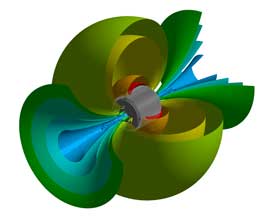Latest release strengthens Pervasive Engineering Simulation product offerings
 India, Aug. 22, 2017 – ANSYS (NASDAQ: ANSS) continues to expand upon its best-in-class products and platform, and deliver on the Pervasive Engineering Simulation vision, with today’s release of ANSYS® 18.2. This latest release brings increased levels of accuracy, speed and ease-of-use – spurring more engineers to use simulation across every stage of the product lifecycle to design cutting-edge products more efficiently and economically.
India, Aug. 22, 2017 – ANSYS (NASDAQ: ANSS) continues to expand upon its best-in-class products and platform, and deliver on the Pervasive Engineering Simulation vision, with today’s release of ANSYS® 18.2. This latest release brings increased levels of accuracy, speed and ease-of-use – spurring more engineers to use simulation across every stage of the product lifecycle to design cutting-edge products more efficiently and economically.
“More companies are turning to simulation to drive increasingly rapid and innovative product development and gain deeper insight into product design,” said Mark Hindsbo, ANSYS vice president and general manager. “Our customers rely on ANSYS engineering simulation technology to cut costs, limit late-stage design changes, and tame the toughest engineering challenges. This latest release continues to build upon the industry’s most accurate simulation portfolio, offering enhanced speed and accuracy – enabling more users, no matter their level of experience, to reduce development time and increase product quality.”
Highlights of the release include:
Advanced Visualization and Modelling for Better Antenna Design
In the electromagnetics suite, a new visual ray tracing capability gives engineers insight to better understand how high-frequency electromagnetic waves interact with a large-scale environment. This technology is ideal for antenna placement studies and radar scattering simulations. In addition, a new RF Link Analysis is available for modeling the quality of wireless links in the presence of electromagnetic interference (EMI) and radio frequency interference (RFI). This release also introduces new wireless propagation loss models for outdoor and indoor scenarios that include effects such as rain, atmospheric absorption, building structure absorption and statistical signal fading models for urban settings.
Increased Speed for More Robust Electronics Design
With ANSYS 18.2, engineers can quickly solve larger classes of printed circuit boards and electronic package simulations thanks to the newly incorporated Phi meshing technology in the ANSYS® HFSS™ 3-D environment. ANSYS 18.2 provides further computational speed advancements with a new automated flow for multi-level, high-performance computing that provides users with highly scalable shared and distributed compute resources.
New Acoustics and Topology Optimization for Quieter and Lighter Products
ANSYS 18.2 delivers new solutions through expanded physics in the mechanical suite that will drastically increase product quality. Users will benefit from a new automated solution to set up drop test simulations and removes the need to make simplifications, while guiding users through the process of running an accurate simulation. ANSYS 18.2 introduces systems for engineers to study the occurrence of vibro acoustics to better understand noise performance in products, such as motors, speakers and car exhaust systems. The ANSYS topology optimization solution has new manufacturing controls that allows engineers to reduce material cost and product weight across more applications.
Faster, More Detailed and Accurate CFD Models
In the fluids suite, designers can solve tough design problems in less time. Patented polyhedral unstructured mesh adaptation (PUMA) automatically refines mesh to resolve fine details while leaving coarser mesh in place elsewhere – drastically shortening solve times. New capabilities extend the ability of pump designers to accurately model cavitation into challenging operating conditions not previously possible, such as very high pressures and mixtures made up of multiple fluids.
Integrating Systems and Failure Analysis for Safer Products
In the systems and embedded software suites, ANSYS 18.2 integrates ANSYS® medini ™ analyze with ANSYS® SCADE® Architect™, the ANSYS embedded system architecture modeling tool. This revolutionary integration provides engineers with a seamlessly integrated toolkit that provides a reliable, step-by-step process to create system architectures that address industry standards for safety and control quickly and cost-effectively.
ANSYS medini analyze now supports transient failure analysis in the systems suite. ANSYS medini analyze is the first tool to introduce a transient failure modeling and distinct failure modes, effects and diagnostic analysis (FMEDA) for chip level safety analysis. New transient failure analysis technology will enable semiconductor companies and chip integrators to efficiently validate its designs at any stage of the development cycle. Safety engineers can compute enhanced failure metrics to analyze the impact of both permanent and transient failures in separated and combined ways.
Introducing Topology Optimization and Transient CFD for Design Engineers
ANSYS® AIM® now supports topology optimization to obtain the ideal strength-to-weight ratio of structural bodies and recommend optimal shapes otherwise too complex to envision. This technology gives users several options to refine and fine tune the simulation to obtain the desired results. This release also offers enhanced solution control for magnetics and support for time-dependent fluid flow, heat transfer and particle flow.
ANSYS® SpaceClaim® is now more robust in data handling in ANSYS 18.2. SpaceClaim enhances the transfer of shared topology data for downstream simulation, and greatly speeds up model inspection operations for manufacturing processes like 3-D printing, molding or casting, regardless of model type.
For more details about the release, please visit http://www.ansys.com/products/release-highlights. Current customers can now download ANSYS 18.2 from the Download Center on the ANSYS customer portal.






